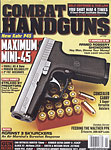
NEW KAHR ARMS P45
New breed mini-45 is the maximum mouse gun!
COMBAT HANDGUNS, May 2006, Page 10 - 15 By Walt Ranch
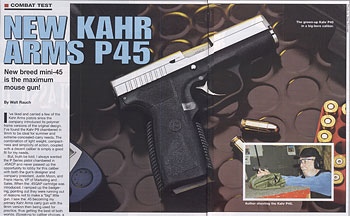 The grown-up Kahr P45 in a big-bore caliber.
The grown-up Kahr P45 in a big-bore caliber.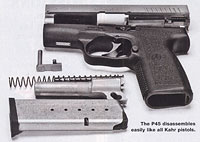 The P45 disassembles easily like all Kahr pistols.
The P45 disassembles easily like all Kahr pistols.
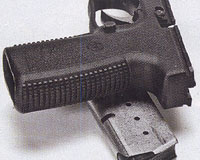 The backstrap has molded checkering with "flats" of grip stippled.
The backstrap has molded checkering with "flats" of grip stippled.
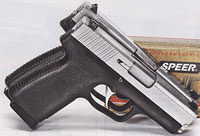 The Kahr P45, rear, and the P9 pistol, front. The P45 is slightly taller and longer.
The Kahr P45, rear, and the P9 pistol, front. The P45 is slightly taller and longer.
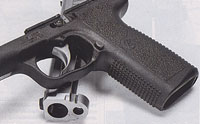 The P45's frontstrap has molded checkering. The round trigger is smooth-faced. The front of the slide is beveled for easier and safer holstering.
The P45's frontstrap has molded checkering. The round trigger is smooth-faced. The front of the slide is beveled for easier and safer holstering.
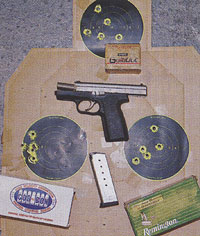 Five-shot 45' groups were below 3".
Five-shot 45' groups were below 3".
 The extractor has "cuts" in it to help keep it clean. It also serves as a loaded-chamber indicator.
The extractor has "cuts" in it to help keep it clean. It also serves as a loaded-chamber indicator.
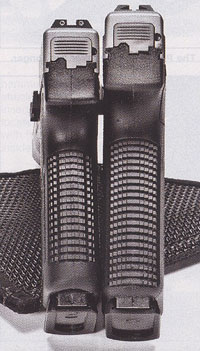 Kahr P9, left, and P45, right. The P45 is a bit wider for fatter .45ACP.
Kahr P9, left, and P45, right. The P45 is a bit wider for fatter .45ACP.
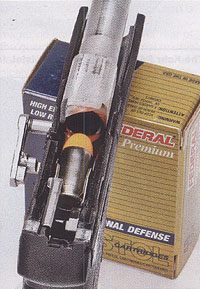 The P45's feed ramp is offset to the left, but this does not interfere with the almost-direct cartridge chambering.
The P45's feed ramp is offset to the left, but this does not interfere with the almost-direct cartridge chambering.I've liked and carried a few of the Kahr Arms pistols since the company introduced its polymer frame versions of the original design. I've found the Kahr P9 chambered in 9mm to be ideal for summer and extreme-concealed-carry needs. The combination of light weight, compactness and simplicity of action, coupled with a decent caliber is simply a good fit for my needs.
But, truth be told, I always wanted the P Series pistol chambered in .45ACP and never passed up the opportunity to lobby for this caliber with both the gun's designer and company president, Justin Moon, and Frank Harris, VP of Marketing and Sales. When the .45GAP cartridge was introduced, I ramped up the badgering, pointing out they were running out of reasons not to make a "big" little gun. I saw the .45 becoming my primary Kahr Arms carry gun with the 9mm version then being used for practice, thus getting the best of both worlds. (Speaking to caliber choices, a 9mm is fine, but the .45 has kept me alive!)
Well, an old saying is "All good things come to those who wait." I now have my Kahr in .45ACP, the P45, and it has already proved to be what I had hoped for in a Kahr pistol.
Gun Details
When I first examined it, I was both delighted that Kahr had finally made the gun, yet concerned that it just might not work reliably. Not that Kahr pistols have not historically been reliable right out of the box; quite the contrary. They all have been so with a few minor expectations when the guns sent were pre-production samples.
I've had a defective magazine catch and, speaking to my real concern, one gun had a recoil spring lose its strength within a few rounds.
My discomfort promoted two actions. First, I went to the range, where Joe Venezia and I fired about 150 rounds of a mixed lot of ammo: Remington 185 and 230-grain JHP Golden Saber, Hornady 230-grain XTP JHP, Magtech 230-grain JRN, Winchester White Box 230-grain JRN, Cor-Bon Performance Match 230-grain JRN and CCI Gold Dot 230-grain JHP. While shooting this last, the slide hesitated when fully to the rear during rapid fire. Later, I could find no indicators of failure with the captive recoil spring system.
Historically, the recoil spring system and magazine springs have been the problem areas for me with ultra-compact 1911s in .45ACP. I've found that the guns are simply too demanding and very individual in how many rounds can be shot before those two need to be changed. (I have a very nice, lightly customized Colt Defender, now out of production, spending its life in my gun safe because it's just too much trouble to keep running at an optimum level.)
Joe and I also shot it for groups indoors, under the usual (for me) lousy lighting at 15 yards. Five-shot groups, fired seated with a table rest gave me 2 to 3 inches with Cor-Bon, CCI, Gold Dot and Remington Golden Saber, respectively.
The new P45 is best viewed as a fully matured Kahr gaining some girth and weight from its youth in 9mm and .40. It's a bit taller and longer as well. Other than these minor enlargements, though, the P45 is all standard Kahr.
It is striker fired and semi-double action, based on a Browning-inspired locked-breech design. As such, the striker is partially pre-loaded or cocked when the action is cycled and the chamber loaded. The gun is safe to carry this way as, in addition to moving the trigger 0.38 of an inch to fire, trigger pull weight of 6 pounds on my scale must be overcome, as well as freeing the immobilized striker from its passive firing pin safety. There is no re-strike capability; the slide must be at least partially retracted to reset the striker. The trigger pull on this one was particularly smooth out of the box, measuring exactly 6 pounds. The hammerless and somewhat-squared stainless steel slide travels on four steel inserts, or rails, two of which are located at the top rear of the frame with the front two rails cleverly inserted inside the frame's dust cover.
The Kahr design has but two external moving parts, the slide stop and magazine release. Both are on the left side of the frame, the slide stop is just over the triggerguard and the magazine catch is at the lower rear of the guard. There is no external manual safety. The pistol's metal parts are all nicely beveled, save one (more on this later), with the only sharp edges being the point of the impressed checkering on the frame's front and backstraps.
The single-column steel-body magazine has a polymer base plate, which also serves as a base pad. It is well secured with an interlocking plate between the pad and spring, easily removed for cleaning. This base plate encircles the magazine body, allowing it to be longer, which in turn avoids over-compression or cramping of the magazine spring (the nexus of the problem with subcompact 1911 magazines). This also makes the magazine easier to load without busting a thumb! When in the gun, the pad fits flush against the frame.
Five cartridge "witness" holes on either side of the magazine body allow quick visual verification of the number or rounds in it. The follower is polymer with a steel insert in its top left and forward corner, which bears against and operates the steel slide stop. This prevents premature wear on the follower due to the steel slide stop lug abrading it.
Supplementing the previously mentioned impressed checkering, the slides of he frame have light stippling molded into them. The ramped front and rear square notch sights have a white dot in the front and a vertical white bar beneath the rear sight notch. These "Von Stavenhagen" sights are dovetailed onto the slide, allowing easy installation of factory-optional night sights. THis dovetailing allows windage corrections to also be easily made.
Breaking the gun down for cleaning is almost easy. All that's needed is to take the slide stop out to allow the slide assembly to be taken off the frame. Each of the Kahrs has faint "tic" marks on the slide and frame that must be aligned to get the slide stop out. The "almost" comes, for me, in removing the slide stop. This should be a "no tool" operation, but I find I have to get something hard to push the pin put. The recoil spring and guide are removed and re-installed in the normal manner. Reading the instruction book is mandatory, as there is a significant caution necessary during reassembly. If you don't get the barrel aligned correctly with the slide stop, you'll lock the gun up solid and it must be returned to Kahr Arms to get it unjammed!
The Kahr Arms pistol has patents on the cocking cam, striker and the manner in which the trigger is attached to the trigger bar, with other design patents pending. One very innovative idea was repositioning the feed ramp such that it is left of the bore line center allowing the trigger drawbar to lie flatter against the right side of the frame. This allows for a narrow slide and frame width.
Range Time
After the "quickie" range shoot and following the detailed inspection, I still had questions. Would the P45 work with a wide range of .45 ammo, and was the gun shooter and/or ammunition sensitive? I've found that some subcompact pistols require a grip that's firmer than their larger versions with every shooter having to supply the necessary "body work" to have the gun work well. In addition, some subcompacts like only certain bullet shapes, weighs and velocity levels.
My solution was to once again enlist the aid of the Lower Providence Rod & Gun Club Pistol Group. This time I really lucked out, for not only was the group shooting; it was the annual Christmas party, so more shooters than normal were on hand. I provided the gun, two magazines and a range bag of the following ammunition: Remington 230 and 185-grain Golden Saber JHP, Silver Bear 230-grain JRN, Precision 155-grain frangible RN, 3-D brand/Hornady 230-grain JHP, CCI Gold Dot 230-grain JHP, Winchester 230-grain SXT Personal Protection and Cor-Bon Pow'RBall 165-grain +P JHP.
The 25 shooters present ran all this through the P45 in less than 45 minutes with only a few failures to feed. We did two re-lubrications during the shoot. The failures to feed were cleared by either hitting the back of the slide or dumping the offering round. I was able to see two of these but not the third, and at that particular time, the gun was very hot, dirty and dry. Other malfunctions were caused by reloads; either not sized or crimped sufficiently for the Kahr's chamber. This mini endurance test did find one more area that needs addressing. The rear edges of the slide stop are sharp and some shooters with long fingers and a thumb-forward shooting grip had their off-hand thumb nipped by the edges.
More than a few of the shooters had never fired a Kahr, nor were they at all familiar with the DAO trigger. All this being said, everyone apparently liked the gun and more than a few told me so. In fact, these folk's enthusiasm was evidenced by their asking to use their own ammo when our 350 rounds had run out. This makes a total of 500 rounds through the gun, counting the first range-day shoot.
Right now, the only two holsters I have on hand for the P9 model also work for the P45. Both are from DeSantis Leather. The Nemesis pocket holster and the IWD Cozy Partner, which I was able to stretch the letter leather rig despite its form-fitting design.
Final Notes
What's else? All I need now are more magazines and a couple of magazine carriers, because this P45 is definitely a keeper. And it just so happens I can justify this purchase as my 2005 Christmas present for myself!
<< Go back to Previous Page